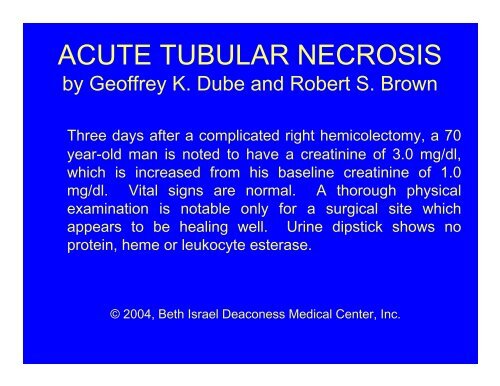ACUTE TUBULAR NECROSIS
ACUTE TUBULAR NECROSIS ACUTE TUBULAR NECROSIS
ACUTE TUBULAR NECROSISby Geoffrey K. Dube and Robert S. BrownThree days after a complicated right hemicolectomy, a 70year-old man is noted to have a creatinine of 3.0 mg/dl,which is increased from his baseline creatinine of 1.0mg/dl. Vital signs are normal. A thorough physicalexamination is notable only for a surgical site whichappears to be healing well. Urine dipstick shows noprotein, heme or leukocyte esterase.© 2004, Beth Israel Deaconess Medical Center, Inc.
- Page 2 and 3: Three days after a complicated righ
- Page 4 and 5: In ATN, a large amount of proteinur
- Page 6 and 7: This slide demonstrates several of
- Page 8 and 9: Shown above is the urine sediment f
- Page 11 and 12: Tubular cell casts occasionally may
- Page 13: Our patient’s sediment also conta
<strong>ACUTE</strong> <strong>TUBULAR</strong> <strong>NECROSIS</strong>by Geoffrey K. Dube and Robert S. BrownThree days after a complicated right hemicolectomy, a 70year-old man is noted to have a creatinine of 3.0 mg/dl,which is increased from his baseline creatinine of 1.0mg/dl. Vital signs are normal. A thorough physicalexamination is notable only for a surgical site whichappears to be healing well. Urine dipstick shows noprotein, heme or leukocyte esterase.© 2004, Beth Israel Deaconess Medical Center, Inc.
Three days after a complicated right hemicolectomy, a 70 year-old man isnoted to have a creatinine of 3.0 mg/dl, which is increased from hisbaseline creatinine of 1.0 mg/dl. Vital signs are normal. A thoroughphysical examination is notable only for a surgical site which appears to behealing well. Urine dipstick shows no protein, heme or leukocyte esterase.How do the results of the dipstick help narrow yourdifferential diagnosis?a. The dipstick is consistent with a nephrotic urine.b. The dipstick is consistent with a nephritic urine.c. The dipstick is consistent with a combined nephrotic andnephritic urine.d. The dipstick is consistent with a diagnosis of acutetubular necrosis, pre-renal azotemia, or post-renalobstruction.
In acute tubular necrosis (ATN), there isischemic or toxin-induced damage to thetubular cells, resulting in cell death and cellsloughing into the urine. Some tubular cellsmay also be shed in the urine due todefective adhesion to either adjacent cells orthe tubular basement membrane.
In ATN, a large amount of proteinuria, which ischaracteristic of the nephrotic syndrome, and a dipstick thatis positive for heme and pyuria, which is characteristic ofthe nephritic syndrome, are often absent. However, thesefindings may be present if there is a concurrent glomerularor interstitial process or if there was pre-existing renaldisease. In such cases, the urine dipstick will be positivefor mild-moderate protein, heme, and leukocyte esterase.In renal failure due to pre-renal azotemia or post-renalobstruction, the dipstick usually does not show evidence ofproteinuria, hematuria or pyuria unless there is pre-existingrenal disease.
The patient’s urine sediment is shown above. Which ofthe following elements are present?a. Erythrocyte castsb. Coarse granular, “muddy brown” castsc. Waxy castsd. Tubular cell casts
This slide demonstrates several of the coarsely granular,“muddy brown” casts (single-headed arrows) that areassociated with acute tubular necrosis. It alsodemonstrates several waxy casts (double-headed arrow),many erythrocytes (curved arrow), and cellular debris, allof which may be seen in ATN.
Our patient’s urine also contained several waxy casts (above left, arrows).Waxy casts derive their name from their appearance, which looks like meltedwax. Waxy casts are thought to be the end result of granular castdegeneration. Since cast degeneration is a slow process, waxy casts aremost likely to form in nephrons with diminished urine flow. Waxy casts maybe broad or narrow. Broad casts, as seen in the slide on the right (arrow),are given their name because they are wider than other types of casts.Broad casts may have a waxy appearance (as seen in the slide on the right).They may also have a granular appearance. Broad casts are a sign ofchronic renal failure, since they form in the enlarged tubules of the remaininghypertrophic nephrons. The slide on the right also contains severalerythrocytes.
Shown above is the urine sediment from anotherpatient with acute tubular necrosis. It is denselypacked with the coarse granular, “muddy brown”casts that are characteristic of ATN. There is also asignificant amount of cellular debris.
This slide demonstrates another example of a coarse granular cast. Thegranules in these casts may be either coarse or fine and may be either clearor dark. The granules within the casts are thought to represent degeneratingcells and filtered proteins that have subsequently aggregated. Althoughgranular casts are a non-specific finding, since they are composed ofelements that are not normally found in urine their presence in the sedimentsuggests the presence of intrinsic renal disease. This cast is also anexample of a broad cast. Broad casts develop in hypertrophic nephronsand are usually seen in chronic renal failure.
Tubular cell casts occasionally may be seen in acute tubularnecrosis. Tubular cell casts form when tubular cells complexwith Tamm-Horsfall mucoprotein in the urine. The tubular cellswithin the cast appear as round or oval cells with a largenucleus. If tubular cell degeneration occurs, the distinctionbetween tubular cell casts and leukocyte casts can be difficult.
In addition to ATN, tubular cell casts may also be seen in any othercondition associated with severe tubular damage, such as acuteinterstitial nephritis of any cause, the acute nephritic syndrome, or thenephrotic syndrome. Lipiduria in the nephrotic syndrome can causetubular cell damage, resulting in tubular cell desquamation and theformation of tubular cell casts. Lipiduria is discussed in more detail inthe section on the nephrotic syndrome.
Our patient’s sediment also contained several isomorphic erythrocytes(arrow). When ATN is associated with concurrent hematuria, the bleeding isusually non-glomerular, i.e., acanthocytes and dysmorphic erythrocytes areabsent. The presence of erythrocyte casts in the sediment (as seen in theslide on the right) should raise suspicion for an acute glomerulonephritis,vasculitis, or much less commonly, an acute interstitial nephritis. Inglomerulonephritis, erythrocytes should appear dysmorphic andacanthocytes may be visible. The erythrocytes should be isomorphic inacute interstitial nephritis. Hematuria is discussed in more detail in thesection on the nephritic syndrome.



